#French restoration fashion
Photo

ca. 1828 Paulína von Lebzeltern by Konstantin Danil (Galéria mesta Bratislavy - Bratislava-Staré Mesto, Slovakia). From tumblr.com/history-of-fashion, Her bodice has fan-like pleats.
#1820s fashion#Romantic era fashion#Biedermeier fashion#French Restoration fashion#Paulína von Lebzeltern#Konstantin Danil#large curl coiffure#knotted bun#off-shoulder straight neckline#belt#wrap
90 notes
·
View notes
Text
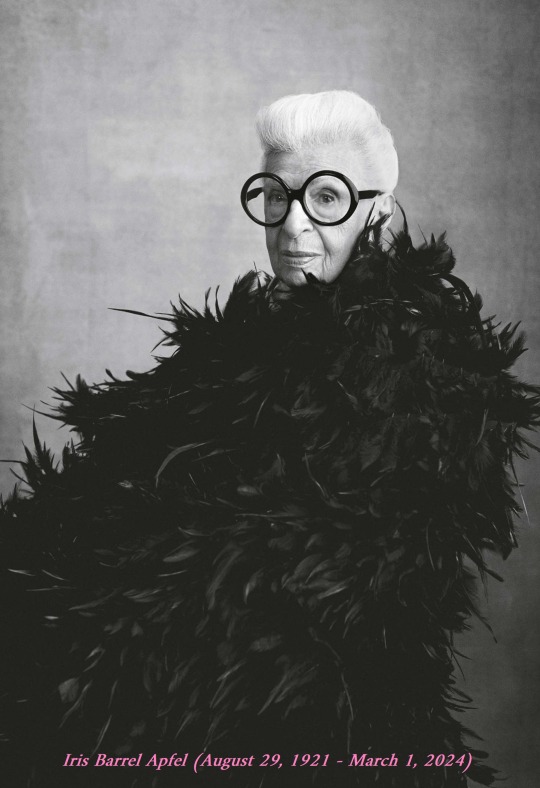
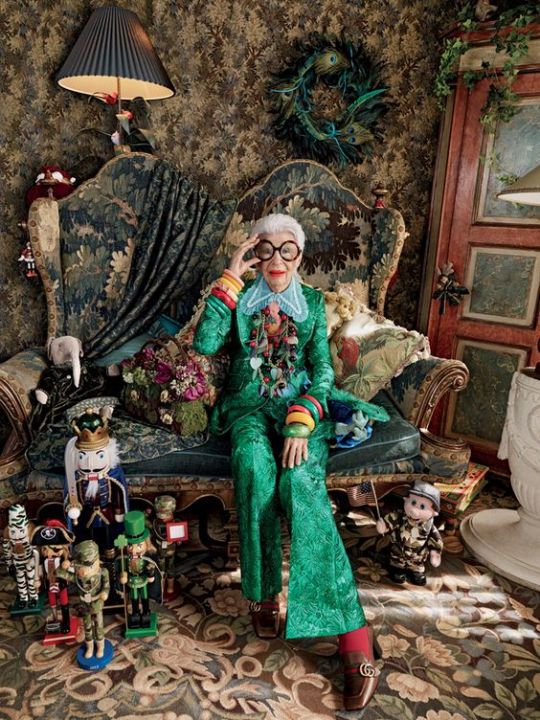
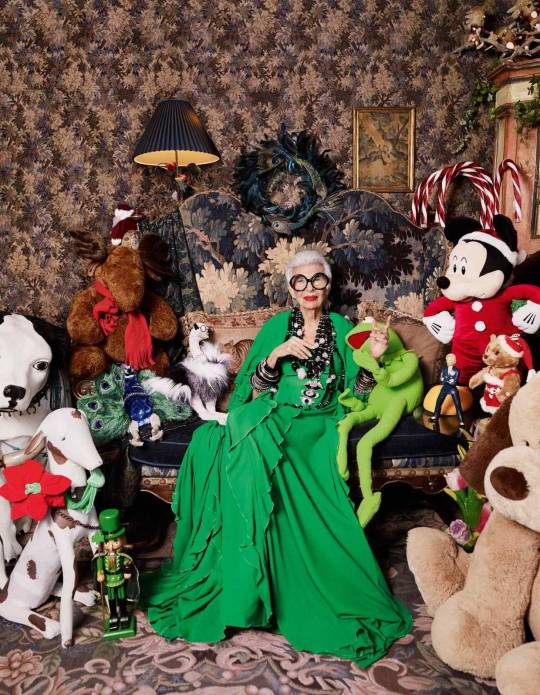
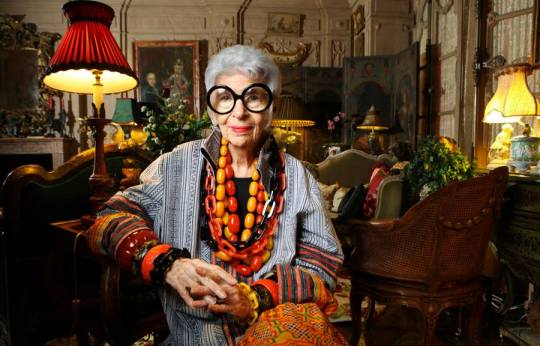
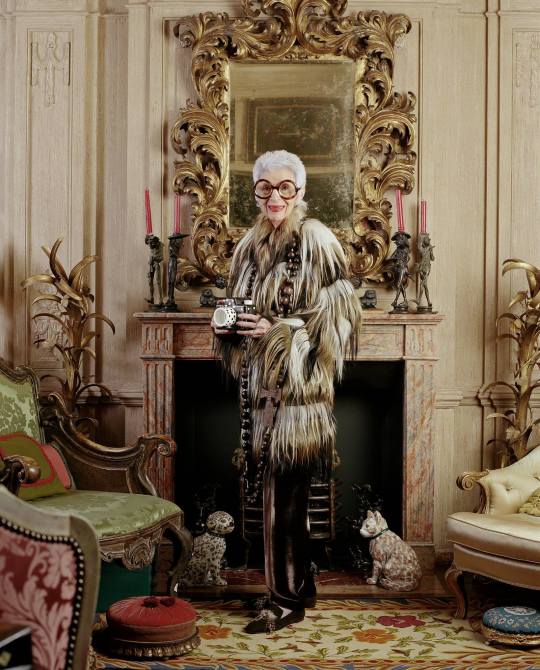
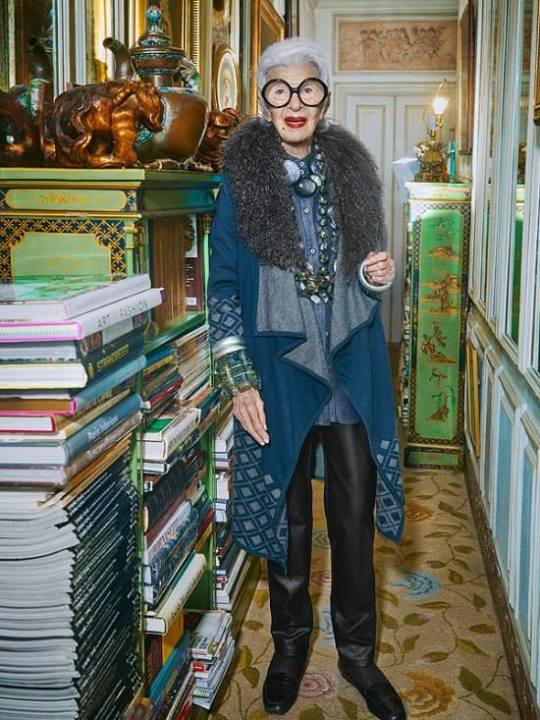
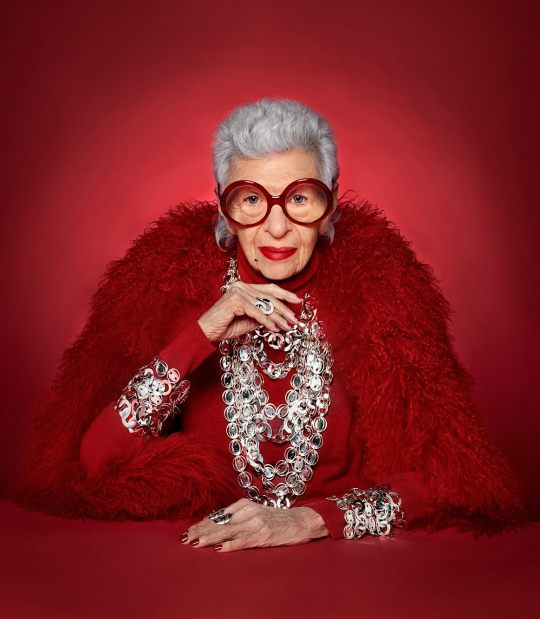

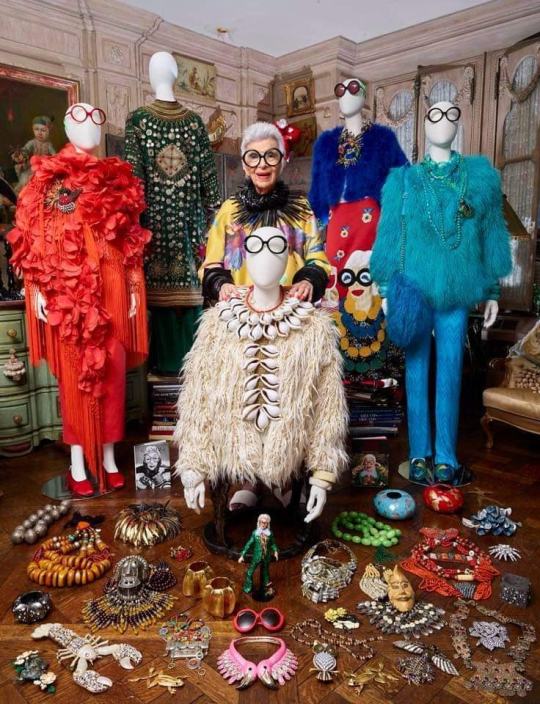

Iris Barrel Apfel, Decorator and Fashion Stylist
(August 29, 1921 – March 1, 2024)
Ms. Apfel was one of the most vivacious personalities in the worlds of fashion, textiles, and interior design, she has cultivated a personal style that is both witty and exuberantly idiosyncratic.
Her originality was typically revealed in her mixing of high and low fashions��Dior haute couture with flea market finds, nineteenth-century ecclesiastical vestments with Dolce & Gabbana lizard trousers.
With remarkable panache and discernment, she combines colors, textures, and patterns without regard to period, provenance, and, ultimately, aesthetic conventions. Paradoxically, her richly layered combinations—even at their most extreme and baroque—project a boldly graphic modernity.
Iris Barrel was born on Aug. 29, 1921, in Astoria, Queens, the only child of Samuel Barrel, who owned a glass and mirror business, and his Russian-born wife, Sadye, who owned a fashion boutique.
She studied art history at New York University, then qualified to teach and did so briefly in Wisconsin before fleeing back to New York to work on Women's Wear Daily, and for interior designer Elinor Johnson, decorating apartments for resale and honing her talent for sourcing rare items before opening her own design firm. She was also an assistant to illustrator Robert Goodman.
As a distinguished collector and authority on antique fabrics, Iris Apfel has consulted on numerous restoration projects that include work at the White House that spanned nine presidencies from Harry Truman to Bill Clinton.
Along with her husband, Carl, she founded Old World Weavers, an international textile manufacturing company and ran it until they retired in 1992. The Apfels specialized in the reproduction of fabrics from the 17th, 18th, and 19th centuries, and traveled to Europe twice a year in search of textiles they could not source in the United States.
The Metropolitan Museum of Art’s Costume Institute assembled 82 ensembles and 300 accessories from her personal collection in 2005 in a show about her called “Rara Avis”.
Almost overnight, Ms. Apfel became an international celebrity of pop fashion.
Ms. Apfel was seen in a television commercial for the French car DS 3, became the face of the Australian fashion brand Blue Illusion, and began a collaboration with the start-up WiseWear. A year later, Mattel created a one-of-a-kind Barbie doll in her image. Last year, she appeared in a beauty campaign for makeup with Ciaté London.
Six years after the Met show she started her fashion line "Rara Avis" with the Home Shopping Network.
She was cover girl of Dazed and Confused, among many other publications, window display artist at Bergdorf Goodman, designer and design consultant, then signed to IMG in 2019 as a model at age 97.
Ms. Iris Apfel became a visiting professor at the University of Texas at Austin in its Division of Textiles and Apparel, teaching about imagination, craft and tangible pleasures in a world of images.
In 2018, she published “Iris Apfel: Accidental Icon,” an autobiographical collection of musings, anecdotes and observations on life and style.
Ms. Apfel’s apartments in New York and Palm Beach were full of furnishings and tchotchkes that might have come from a Luis Buñuel film: porcelain cats, plush toys, statuary, ornate vases, gilt mirrors, fake fruit, stuffed parrots, paintings by Velázquez and Jean-Baptiste Greuze, a mannequin on an ostrich.
The Museum of Lifestyle & Fashion History in Boynton Beach, Florida, is designing a building that will house a dedicated gallery of Ms. Apfel's clothes, accessories, and furnishings.
Ms. Apfel’s work had a universal quality, It’s was a trend.
Rest in Power !
#art#design#fashion#icon#rip#iris apfel#luxury lifestyle#rip riris apfel#style icon#iconic#trend#rare avis#women's fashion#walking closet#muse#themet#style#history#renaissance#baroque#greta garbo#dior#chanel#montana#fendi#jewellery#high fashion#fantasy#women history month
142 notes
·
View notes
Text
Favorite Historical Architectural Styles
Since I've done my favorite historical fashions, I thought it would be fun to do historical architectural styles too. I want to write more about architecture too, but I've started thinking should I do a separate blog for architecture and architectural history or should I just do it all here? I think it would be better in a way that I wouldn't have to worry if anything I want to write is too far from the actual topic of the blog, but then again, there is a lot of overlap, especially when it comes to Arts and Crafts movement (which I'm currently writing my thesis about and which I definitely will talk a lot about), and also I would have to manage yet another blog.
Anyway, I'll again do this from oldest to newest. I will limit myself to western styles (except when we get to Modernism all styles are very international), even though there's a lot of non-western styles I enjoy, but it's what I know most about.
Perpendicular Gothic


I love Gothic architecture in general and the several first entries will be my favorite sub-styles of it. I love the the way Gothic Cathedrals try and so often succeed to feel like forests. I love how the structural elements are used to create the aesthetic. I love the organic visual elements. I love that it's such a unique style in Western architecture. And I love the amazing craftsmanship that went into it.
I'm particularly a fan of English Gothic because of it's insanely beautiful and complex ribbed vaults. From English Gothic my favorite though is the Perpendicular style, which was basically the English late Gothic. It's characteristics can be seen in the second pic. It has the stretched arch and the very flowing and organic traceries. I do include here the rest of English Gothic too, since even though the Perpendicular style is my favorite of them, all if it is still one of my Gothic favorites.
German Late Gothic


As it's becoming clear I love Late Gothic architecture in general the most, and in the geographical axis I also love German Gothic. Early and High Gothic were mainly divided into French and English styles and the French style dominated in the continent, just being altered a little to the local building traditions outside of France, but during late Gothic it diverged much more strongly into different styles.
German Gothic also has beautiful complex faulting (though less insane than English) and it also has that same pursuit of massive height French Gothic has. Those combined with that Late Gothic's more streamlined flowing and organic aesthetic, some of the German Late Gothic cathedrals really sell that feeling of standing in a forest.
Finnish "Gothic"

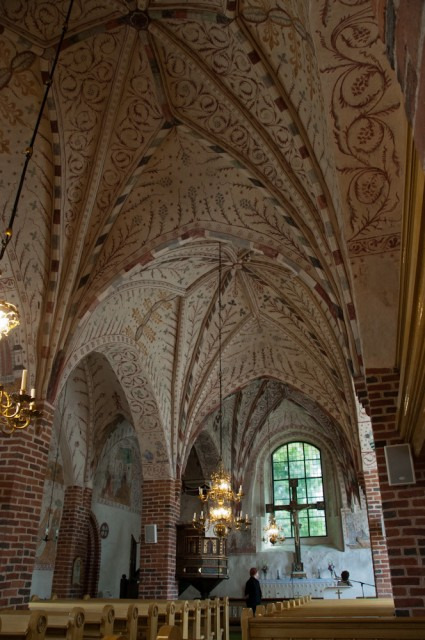
I have a soft spot for the Finnish Medieval stone churches, which are not nearly as sophisticated or detailed as the other European counterparts, but still made with beautiful craftsmanship and they have some cool own features. It's very far from the European Gothic traditions, as you can see, but that's still the influence, hence Gothic in scare quotes. I love the simple outward appearance with the exposed thick stone walls, the details of the gable that worked as the calling card for the building master and the very steep roof. Like everywhere at the time, the roof in these has wooden structure, which is frankly super cool. It was not a simple engineering problem to make a roof that steep and massive at the time, but the structure works so well there's 600 year old roofs with the original logs still working perfectly well. I also really love the original medieval murals in them, which were painted over during the Reformation (you can't have color in a Lutheran church damn it), but thankfully some of them have been restored from under the paint.
Finnish "Renaissance" Log Churches


Renaissance also didn't land in Finland similarly as it did rest of the Europe. When Renaissance was going on in Europe, they still were building those "Gothic" churches here. These log churches were based on Scandinavian version of the Renaissance church, but they didn't really look like Renaissance churches, and were kinda it's own thing continuing a lot of the aesthetics from those Gothic churches. This is a highly specific style, but I just think they are so cool and pretty? Like they really made a CUPOLA out of log.
Arts and Crafts Movement



Arts and Crafts Movement didn't have exactly a style, rather a design philosophy that was more important than specific style. There's of course a lot of stylistic similarities in the works of the different members of the Movement, because they had overlapping sources of inspiration and were influenced by each other, so we can think of it as a style. I could, have and will talk about them for hours, but briefly now: It was a moment in latter half of the 19th century and early 20th century and their goals were reviving craftsmanship skills and professions, socialism, opposing industrialism and abolishing the hierarchy between fine arts and applied arts. They were very much influenced by Medievalism and Gothic art and architecture, though unlike Gothic Revivalist, they took more from the guiding principles than the aesthetics. They basically started Modernism and lay ground to all the Modernist architecture's main principles, like form follows function.
Art Nouveau


Art Nouveau was directly influenced by the Arts and Crafts Movement and was the first mainstream Modernist style. I especially love the more toned down Finnish Art Nouveau, or Jugend as it's called here, but I do love the style more broadly too. I'm not that into those almost Baroque style versions of it though, with barely any straight lines. I love the round doors, the stylized floral patterns and the use of light.
Organic architecture



This has to be my favorite modernist/post-modernist (?) style. It's direct successor of Arts and Crafts movement and it's also more of a design principle than a unified style. There is some stylistic similarities, but it is stylistically very diverse philosophy. It was most prominent during the 20th century, but it always stayed in the sidelines, though there are still architects who might be considered practicing organic architecture. Organic architecture is all about living in harmony with nature, taking inspiration from it, designing the building to fit the building spot and the surroundings, extra care taken in to preserve the nature already there, and using local natural materials when possible. My favorite architects are Raili and Reima Pietilä, who were most prominent organic architects in Finland. (I almost moved into apartment designed by them, but it was in pretty bad condition, so it wouldn't have unfortunately been worth the price.)
Brutalism


I know it's not for everyone and it's not easy to make it work but when it works, it really does. It was born in 1950s during the reconstruction era. Brutalism is not just concrete though. The point is to show the raw materials and the structural elements. Technically a lot of Gothic and Arts and Crafts architecture is then brutalist. Timber frame architecture? Also brutalist. I'm only half joking, of course the style itself is also very bare and, well, brutal, but I love it for the same reasons. I really love bare textures of materials and exposing the materials of the structural elements. And I do actually really like the texture of concrete. Though I will say concrete is destroying our world and we should use it as little as possible. But we should also protect old buildings and keep using them rather than built new ones, so I feel fine admiring the old brutalist buildings. The best brutalist buildings combine materials very intentionally and make works of art with the light.
Bonus - Favorite contemporary architecture: Traditional methods



As we're living in the post-modern times, there's not really unified and specifiable styles or architectural ideologies anymore. They all kinda flow into each other and architects don't organize themselves into clear groups based on style and design philosophy. So it's hard to put into words the style I like in contemporary architecture. There's been growing interest in studying traditional structures and methods, learn from their sustainability and incorporate them into contemporary architecture. They are techniques that have been developed through trial and error on the span of centuries, so we really don't have to reinvent the wheel here. Traditional methods of a given area have also been developed for that area and it's climate, from the materials available there, so they also push us to use local materials. Typically these traditional structures are very simple, often made from solid material, which makes them easier to built without construction error (a huge problem in modern structures), and easier to fix and maintain, when inevitably there is issues. Also they are beautiful, definitely more so that steel and glass. I love solid brick structures, log structures, timber frames, natural stone, rammed earth and all of them, especially when these beautiful materials are left bare.
#architecture#architectural history#historical architecture#history#art history#modern architecture#gothic architecture#brutalism#arts and crafts movement#art nouveau
536 notes
·
View notes
Text
From a thing to wear to an icon of culture 👘

There is this hidden detail in Muzan that when I noticed I could not help but smile. Remember how he said that the thing he hated the most was change? Well coming from someone that had to live in 5 different eras is kinda funny, and it's even funny when you realize that he ended up adopting the Western fashion pretty fast. But that's the twist, if you look at Muzan's vest you come to realize that it's the exact same pattern as the kimono he used to wear. The best part? That was a thing that actually happened in history.
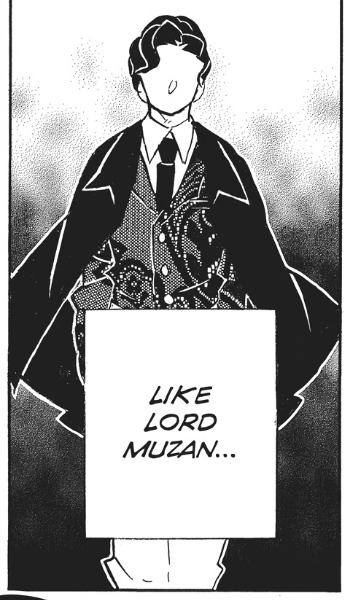
Wanting or not, the clothing that the people used to wear represents the history they lived through. "To look seriously at art objects of the everyday, such as clothes - their discourse and practices, their meaning-bearing forms and their codes of internal and external interpretations - in an essential, and often neglected, component of any study of modern aesthetics." - Slade, 2009
Yofuku [Western Clothing] is a type of clothing that is now common all over Japan, but during a lot of time, it was a type of clothes that only selected few grew up with. The 1st contacts with these types of clothing [even if extremely different from what we now call western clothing] was in the 16th century when the Portuguese arrived in Tanegashima. With them came not only different shapes but also different fabrics. But the “true” introduction to western fashion would only happen with Commodore Matthew Perry, catharsis to the Meiji restoration, where Emperor Meiji would start to dress in a typical western military outfit, and soon after the empress would start to aper in the typical victorian dresses.
In the Edo period clothing visually distinguished the social classes. "Certain articles of clothing visibly differentiated people of diverse social classes, and simultaneously distinguished an individual within a specific group. The materials, motifs and construction of military campaign coats, for example, marked their wearers as men belonging to the military class." - Milhaupt, 2014; Samurai ranked on the top, followed by farmers, artisans, and merchants on the bottom. What happen was that most of the times the samurai where poor while the merchants lived in economic success. But samurai had the privilege of using certain types of fabrics and patters, even tho most of the times they could not afford them, and so, the merchants would start to adapt the fabrics and patters they were allowed to were and would end up becoming the patrons of arts and fashion. The trends of fashion would later be documented in ukiyo-e, and not only in the work of art sense, but also in pattern books were people could browse the prevailing styles.
After the 1st contacts with the westerners, what would start to happen is that slowly but surely the Japanese would start to integrate the western ways of dressing into their lives. The Japanese started to introduce some of its elements with the kimono, shoes, hats, gloves, glasses, umbrellas, etc. Then in the 19th century a full change would happen starting from the man in the highest classes to the man in the lowest classes. The emperor decided to cut his topknot in 1872 and started to dress in western clothing in official appearances, also changing some of the more cultural habits like eating meat and more wester kind of meals. In the official portraits he appears adorned with a French-style military uniform with ornaments in gold and ostrich feathers. Before this, the emperor was never a public figure, so when pictures of the Meiji Emperor became available, and he started to appear more publicly the nation would have their eyes on him and start to imitate him.
Women would, for the longest time still dress in the now classic kimono, that would develop as a symbol of the old and traditional Japan. The idea of the western clothing being associated with a modernized Japan and the Kimono [that literally means “thing to wear”] to a traditional country came from the fact that the emperor would choose to wear western clothes in more formal, international events, and for religious national events would choose the traditional Japanese court dress. The western clothes will end up being a symbol of the modernization of Japan, and the Meiji government would use it as yet another tool of national control.
For all the Japanese born after 1945 the western clothes became the norm. Most families would end up transforming their kimonos into western clothing pieces, and the patterns sold for kimonos would double for kimonos and western clothing.

But it is funny to notice how despite it all Muzan is the one being presented in western clothing and Ubuyashiki is the one in traditional clothes, always being the contradiction of the other, but also it can also be interpretated as the Ubuyashibi family being "trapped" in the past since in hundred years the corps never killed an upper moon, the history never changed. And Muzan in his ever-changing cycle of his life, in the changing of eras and changing of personas he decided to reuse the only thing he could: his clothes. And just like him, they would adapt through the times.

MILHAUPT, Terry Satsuki. 2014 - Kimono: A Modern History. London: Reaktion Books [Ebook];
SLADE, Toby. 2009 - Japanese Fashion: A cultural History. Oxford, Berg. [Ebook];
#demon slayer#history#demon slayer from history to fantasy#demonslayerfromhistorytofantasy#history research#japanese history#demon slayer history#kimetsu no yaiba#research#demon slayer muzan#muzan kibutsuji#ubuyashiki#kimono
187 notes
·
View notes
Photo

C'est fou comme les gens ont de moi cette image de femme sophistiquée, glaciale. C'est une telle erreur, c'est tellement mal me connaître.
- Catherine Deneuve on herself in Belle de Jour (1967)
In anticipation of a new film this summer by Catherine Deneuve called ‘Bernadette’ where she plays Bernadette Chirac, the wife of French Jacques Chirac, I’ve been re-watching some her back catalogue of films. She’s done over 64 films and at almost 80 years old she’s still going strong. And yet out of her many films I’ve always been drawn back to one film which has become a cult classic. Watching it and re-watching it and even gorging on books on its making, new intriguing details reveal themselves about this landmark French art house classic - Belle de Jour (1967).
I once had the privilege of having dinner with her - or rather sat around the same table - through a Parisian host and his lovely wife who had gathered an eclectic group of friends across generations together. I was too self-conscious to talk about her film career directly. I was on surer ground when we indulged in small talk where she was perfectly down to earth and very pleasant. I felt it would be rude to go all fan girl on her and pepper her with questions about Belle de Jour in particular as she’s known to be very ambivalent about her experience of the film - a film that really defined her in the eyes of many people.
But it didn’t mean she didn’t recognise its cultural importance though as she was quite happy to amuse us with a funny story about Belle de Jour. A newly restored 35mm version was funded by the fashion house Saint Laurent back in 2018. Deneuve always had a close relationship with Yves Saint Laurent and also the fashion house. She was the one to introduce Buñuel to Saint Laurent. So the fashion house had a glitzy premiere in New York. But they didn’t count on many of their guests being late. Most of the guests were stuck in the New York traffic and the rain. However Martin Scorsese was the only one to get out of cab and run like a mad man through the pelting rain and huge traffic. A true cinephile, he was so desperate to see the film restored to its former glory that he would go to any lengths to see it.

In Belle de Jour, Catherine Deneuve, whose limpid beauty is capable of sustaining any interpretation, is a perfect Severine and demonstrates a remarkable control in progressing, with enormous economy of gesture and movement, from frigidity to physical warmth as the bored housewife who indulges in part time sex work.
“I felt they showed more of me than they’d said they were going to,” Catherine Deneuve remarked to Pascal Bonitzer in 2004, about the making of Luis Buñuel’s 1967 Belle de jour. “There were moments when I felt totally used. I was very unhappy.”
The story of Séverine, a deeply disenchanted haute bourgeois Paris housewife who finds erotic liberation through byzantine psycho-sexual fantasies and part-time work at an upscale brothel, Belle de jour certainly made extreme demands of Deneuve: her character is flogged, raped, and pelted with muck, among other assaults. But despite her objections to the way she was treated and her difficulties with Buñuel, Deneuve’s performance in Belle de jour turned out to be one of her most iconic.

Deneuve, who had become a star only three years earlier, as the melancholy jeune fille in Jacques Demy’s 1964 all-sung musical The Umbrellas of Cherbourg, was just twenty-three when Belle de jour came out; notably, Buñuel’s film was released in France less than three months after Demy’s radiant, MGM-inspired musical The Young Girls of Rochefort, starring Deneuve and her real-life sister Françoise Dorléac.
But Belle de jour, more than any other film from the first decade of her career, defined what would become one of the actress’s most notorious personae: the exquisite blank slate lost in her own masochistic fantasies and onto whom all sorts of perversions could be projected. (Deneuve as deviant tabula rasa was first seen in Roman Polanski’s 1965 Repulsion, in which she plays a damaged beauty plummeting into psychosis; but Belle de jour doesn’t portray its heroine as mad, instead remaining deliberately ambiguous about the origins of her unconventional desires - and presaging the bizarre libertines she would later play in such films as Marco Ferreri’s Liza, 1972, and Tony Scott’s The Hunger, 1983.)

Buñuel was at a very different stage of his career from his young star, but Belle de jour represented a peak for him as well, the greatest - and most successful - film of his extremely rich late period. These works, bookended by 1964’s Diary of a Chambermaid and 1977’s That Obscure Object of Desire (his final film), were made mostly in France - where Buñuel had begun his filmmaking career with the incendiary, surrealist Un chien andalou (1929) - following the exiled Spanish director’s two decades in Mexico.
Many of these late projects were cowritten with Jean-Claude Carrière and focus intensely on sexual perversion (a theme that recurs throughout Buñuel’s work). Belle de jour certainly falls into that category, and also, typically, skewers the entitled classes. Yet it stands out as the director’s most intricate character study—but of a protagonist who resists definition; the heroine, frequently trussed up and mussed up, retains an odd, opaque dignity in her debauchery.

In that same interview with Bonitzer, Deneuve was judicious enough to distinguish her experience of making Belle de jour from the final product, calling it a “wonderful film.” But her first meetings with Buñuel hinted at the duress that was to follow. According to John Baxter’s 1994 biography, Buñuel, it took time for the director to “warm to” his star: “He felt, with some justice, that she had been foisted on him, first by the Hakims [Belle de jour’s producers], then by her lover of the time, François Truffaut.” After dining with Buñuel at his house, the book recounts, Deneuve “left with little more than an impression that he disliked actors in general and was reserving his decision about her. The only advice he offered was the advice he had always given actors: ‘Don’t do anything. And above all, don’t . . . perform.’”
Though Deneuve deferred to her director, she was no puppet; Belle de jour is as much hers as Buñuel’s. The filmmaker, famously resistant to “psychological” interpretations of his work, stuffs Belle de jour with his trademarks, confounding any attempt to parse meaning: the surrealist blurring of fantasy and reality, fetishism, sexual perversion, blasphemy.
But as Séverine, Deneuve, despite operating in the nebulous realm between dream and waking, imbues the film with irresistible and very real lust - and luster. Sporting the chicest Yves Saint Laurent finery, Deneuve revels in the peculiar desires of her character while always inviting our own. As Buñuel himself acknowledges in his 1984 autobiography, My Last Sigh (published a year after his death), Belle de jour “was my biggest commercial success, which I attribute more to the marvelous whores than to my direction.” (Per Baxter, after the filming of Belle de jour, he would finally admit of his star, “She’s really a very good actress.”) Deneuve’s gift was to update the world’s oldest profession for her still-expanding résumé.

The director had some modifying to do as well. Buñuel, who adapted Joseph Kessel’s 1928 novel with Carrière, assessed the source material dryly in My Last Sigh: “The novel is very melodramatic, but well constructed, and it offered me the chance to translate Séverine’s fantasies into pictorial images as well as to draw a serious portrait of a young female bourgeois masochist. I was also able to indulge myself in the faithful description of some interesting sexual perversions.”
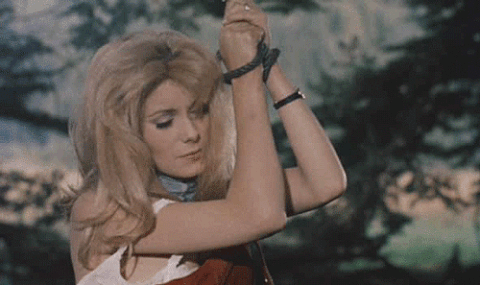
He wastes no time in establishing those bizarre erotic proclivities. In Belle de jour’s opening scene, Séverine and her doting husband of one year, Pierre Serizy (Jean Sorel), a handsome, dutiful surgeon, are snuggled close in a horse-drawn carriage; he interrupts the tender moment with the lament “If only you weren’t so cold.” She pulls away, defensive. The sound of horse bells, which has been increasing in volume from the film’s first shot - and will indicate Séverine’s dreams or fantasies throughout - stops. Pierre orders his wife out of the cab; when she refuses, he and the two drivers remove her by force. She is gagged, bound to a tree, and whipped by the coachmen, who are then instructed by Pierre to rape her. When one begins to ravish her, Séverine appears to be in ecstasy.
This carnal reverie is soon interrupted by the Serizys at home, preparing for their usual chaste bedtime ritual. Pierre, in white pajamas, asks his pale-pink-nightie-clad wife, under the covers in a separate bed, what she’s thinking about: “I was thinking about you . . . and us. We were out for a ride in a carriage”—a scenario Pierre has heard before.

The fantasy clearly belongs to Séverine alone; she finds erotic thrills in her secret thoughts of debasement and humiliation, her florid imagination compensating for her sterile, sexless existence. Her most private desires will soon be realized at 11, cité Jean de Saumur, the address of the boutique bordello run by Madame Anaïs (Geneviève Page), given to Séverine by Pierre’s louche friend Husson (Michel Piccoli).
At Madame Anaïs’s, Séverine - now going by the nom de pute Belle de jour, a reference to her two-to-five shift (she insists on being home when Pierre returns from his workday at the hospital) - is horrified at first but proves to be a quick study. A burly Asian client scares off her two seasoned colleagues with his mysterious, buzzing lacquered box, but she is absolutely transfixed; after the john leaves, she, lying prone on the bed, lifts her head, her luxuriant mane of blonde hair disheveled, to reveal a woman still drunk on orgasmic pleasure.

The contents of the box are one of the film’s many mysteries (when asked what is inside, Buñuel would reply, “Whatever you want there to be”). Yet the greatest enigma is Séverine herself: why does she recoil from the slightest sexual advance from her husband yet lose herself, both in fantasy and in her new line of work, in elaborate masochistic tableaux? “Pierre, it’s your fault too. I can explain everything,” Séverine insists to her husband in the opening fantasy sequence, as she’s being forcibly removed from the landau. But of course, she can’t - and won’t.
As in Repulsion, there are flashbacks to possible childhood trauma in Belle de jour. In one, a man appears to touch a young Séverine inappropriately; in another, she stubbornly refuses the Blessed Sacrament. But unlike in Repulsion, whose final, prolonged shot of a menacing family photo is offered as the root of Carole’s pathology, these scenes in Buñuel’s film are almost non sequiturs, presented not as psychological explanation but as blips in a baroque sexual surrealism.

As Séverine’s reveries and job demands become stranger and more mysterious - in one daydream, she is pelted with thick black mud by Pierre and Husson, who call her “tramp” and “slut”; a ducal client solicits her in the bois de Boulogne to perform in a necrophilic rite - Deneuve retains her porcelain, celestial inscrutability, while simultaneously transforming into an earthbound debauchee, delighting in her own defilement. Madame Anaïs (whose early, shameless flirtation with Séverine - who eventually reciprocates - is the first of the many moments in Deneuve’s filmography that would cement her status as a lesbian icon) touts her new employee’s regal bearing to prospective customers: “[She’s] a little shy, perhaps, but a real aristocrat.”
Séverine’s coworkers, Charlotte (Françoise Fabian) and Mathilde (Maria Latour), are constantly remarking on the impeccable cut and style of her ensembles. Yet what this seemingly untouchable goddess craves most is the brutality of her latest john, the thug Marcel (Pierre Clémenti), a rough with metal teeth, a walking stick that doubles as a shiv, and fetishwear (shiny boots of leather with matching overcoat) that could have been dreamed up in an atelier overseen by Kenneth Anger and Pierre Cardin.
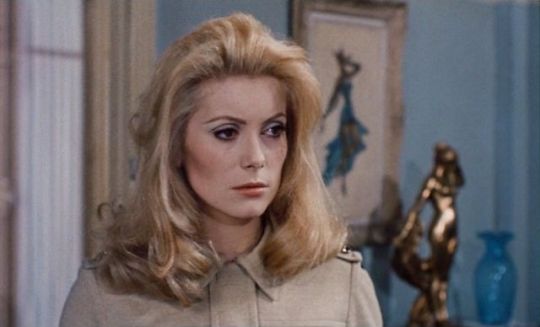
Séverine’s relationship with Marcel will lead to Pierre’s ruin - or does it? The ambiguous ending of Belle de jour suggests that everything that preceded it may have existed only in the heroine’s cracked dreamscape. Like the buzzing box, the film’s final scene is whatever you want it to be.
Yet one thing is certain: Deneuve transcends kink. And despite her misery during the Belle de jour shoot, she would return for even more bizarre treatment three years later in Buñuel’s Tristana, losing both her virtue and a leg.
Almost 55 years after it was made Belle de Jour continues to be a compelling film. It takes on greater curiosity for me as I live in Paris and there are Séverines aplenty that I come across. But the film also speaks to a non-French audience even today as it remains a shrewd commentary on the hypocrisy of social relations and sexual politics. Buñuel invites us to ponder the transgression of a socially respectable woman secretly being a prostitute in the afternoons, but I don’t think he bothered to pose the question why a socially respectable gentleman should be secretly visiting a prostitute in the afternoons - which happens more than one might think and that behaviour is normalised. Something to think about.
#deneuve#catherine deneuve#quote#french#film#movie#cinema#belle de jour#actress#luis bunuel#bunuel#film making#arts#culture#france#scorsese#personal#paris
145 notes
·
View notes
Text

Barbarella will be released on 4K Ultra HD and Blu-ray on November 28 via Arrow Video. Tula Lotay designed the new cover art for the 1968 science fiction cult classic; the original poster is on the reverse side.
Roger Vadim (Into the Night) directs from a script he co-wrote with Terry Southern (Dr. Strangelove, Easy Rider), based on the French comic series by Jean-Claude Forest. Jane Fonda stars with John Phillip Law, Marcel Marceau, David Hemmings, and Ugo Tognazzi.
The limited edition set comes with a booklet featuring new writing on the film by Anne Billson, Paul Gravett, Véronique Bergen, and Elizabeth Castaldo Lundén along with select archival material, a double-sided poster, and six double-sided postcards.
Barbarella has been newly restored in 4K from the original negative in Dolby Vision (HDR10 compatible) with original lossless mono audio and remixed Dolby Atmos surround.
Special features for the two-disc set are listed below, where you can also see more of the packaging and contents.

Disc 1 - 4K UHD:
Audio commentary by film critic Tim Lucas
Alternative opening and closing credits
Isolated score
Disc 2 - Blu-ray:
Barbarella appreciation by film critic Glenn Kenny
Barbarella Forever - making-of featurette by Paul Joyce
Love - 2-hour discussion on the impact and legacy of Barbarella by film historians Tim Lucas & Steve Bissette
Interview with film fashion scholar Elizabeth Castaldo Lundén on Jacques Fonteray’s costume designs
Interview with camera operator Roberto Girometti
Interview with Ricky Tognazzi on his father, Barbarella actor Ugo Tognazzi
Interview with stuntman/body double Fabio Testi
Video essay by Eugenio Ercolani on producer Dino De Laurentiis
Trailer
TV and radio spots
Image gallery
Additional contents:
Booklet featuring new writing on the film by Anne Billson, Paul Gravett, Véronique Bergen, and Elizabeth Castaldo Lundén, plus select archival material
Double-sided fold-out poster with new art by Tula Lotay and original artwork
6 double-sided postcards
It is the year 40,000AD. When evil scientist Durand Durand (Milo O’Shea) creates a deadly weapon with the potential to cause mass devastation, the President of Earth dispatches Barbarella (Jane Fonda) to hunt him down. Crash-landing in an icy wilderness somewhere within the Tau Ceti planetary system, Barbarella is rescued by Mark Hand (Ugo Tognazzi) and guided by the blind angel Pygar (John Phillip Law) to Durand’s lair in Sogo, a city of corruption and debauchery, where an encounter with the Great Tyrant Black Queen (Anita Pallenberg) and her minions throws her mission into jeopardy.
Pre-order Barbarella.
#barbarella#jane fonda#60s movies#1960s movies#sci fi#science fiction#arrow video#dvd#gift#tula lotay#roger vadim#jean claude forest#marcel marceau#ugo tognazzi#60s sci fi
91 notes
·
View notes
Note
Could you do a one shot between bills character in John wick and a quiet noblewoman. Like he begins talking about art and the reader, someone who lost someone important to her and had been quiet ever since, starts to babble with him about art. Everyone is shocked cause she hadn’t talked this much since the death.

“Why do all the French artists paint like this?”you overheard a small American boy ask his Father. The man shrugged his shoulders, looking like he’d rather be anywhere but here.
You really wanted to answer the boy, and to tell him there’s so many more styles if he prefers. The French have so many forms of art ranging from sculptures, to architecture, to elaborate gardens and fashion houses. You wanted to tell him about the gardens of Versailles or the hall of mirrors. Regale him with stories of the amount of effort it takes just to run the hundreds of fountains, spread throughout the vast palace grounds. Tell him about the way French artists fought against oppressors in the most amusing ways, like the story of Christian Dior and the Nazis. You wanted to say so many things, but the words were stuck in your throat, and you felt like the walls were closing in on you.
Just as you were turning around to flee another failure, you came face to face with a breathtaking man. He was not looking at you though, his attention was on the young American boy. He had an annoyed look on his gorgeous features, and just as you realized you were staring at this man he spoke; “Renoir was one of the founding fathers of Impressionism, but unlike Monet and Degas, he was a perfectionist. This is not all France has to offer however, maybe your father should take you to see some of the enormous scenes of battle, that make you feel various emotions. Delacroix is just up ahead.”
The boys eyes lit up and he snatched his fathers hand, enthusiastically pulling him forward to see the famed scenes of war and suffering.
“Degas wasn’t any less of a perfectionist.” You blurted out before you knew what was happening.
The man turned to you and cocked an eyebrow. Grinning slightly, he asked you what your favorite exhibit was in the museum, switching from english to French.
Thrilled to talk about art, with someone who looked like a work of art himself, you began to list your favorite artists currently on display, and only became more enchanted when he shared his impressions of them. You had always been the queen of random facts about various topics, especially art, but as your conversation flowed, you learned several new things from this man.
As you followed him into the newest exhibit to see what he called groundbreaking, you’d nearly forgotten that you hadn’t spoken a word in over a year.
That is until you saw HER.
Emily Devoss, the literal reason your heart had been broken. You’d grown up together and she’d always made a point to make you feel small. She was always the first to point out your flaws, and she’d always seemed out of reach. Seeing her perfect clothing, on her perfect frame, with her perfect smile and perfect hair, reminded you of the worst day of your life.
Completely humiliated and grasping at sanity in front of all your friends and family, you’d received a FaceTime from your husband to be. Heart soaring and hope restored, you’d answered it thinking he’d have an explanation for his tardiness, but were met with him sitting topless by a pool telling you he wasn’t ready for marriage. Completely bewildered that he’d wait till you were standing in a church in your wedding gown,in front of hundreds of people, to decide he wasn’t ready was more than you could comprehend. Then Emily Devoss had come into the frame, and had sat in his lap and bitten his ear and the call had ended.
(A few weeks later, she had dumped him, and he’d had the audacity to expect you to take him back. You’d ignored him; refusing to reply to any communication, or answer your door. You blocked him on everything, but he’d been persistent, calling and texting from strange numbers. Since you weren’t speaking, you never answered calls anyways, but you were able to communicate through text and email. Just not with him.
The thought of any type of communication or contact with that man, turned your stomach.)
Your parents and bridesmaids had seen the FaceTime, since they were all curious where he was too. Overwhelmed and likely in shock, you’d completely shut down and checked out. As the whole situation became more real, and sunk in, You avoided everyone like the plague for the next several months. when it finally came time that you needed to speak, you could not bring yourself to do so. You texted and emailed, the bare minimum, but that was it.
After your mother tried to have you committed, you’d compromised and gone to several therapists. None of them were able to get you to speak. You simply didn’t feel you needed to speak to anyone if you so choose. Being mute wasn’t illegal, and you couldn’t imagine any reason to speak ever again, until today.
“I have been so rude. My name is Vincent, but most call me Marquis. May I have your name?” The beautiful man asked you, unaware of the inner struggle you were fighting.
Unable to take your eyes off Emily more than a few seconds, you bit your lip, as your world began to crumble.
Vincent observed your odd behavior and quickly came to the conclusion that you were distressed by someone in the room. Stepping in your line of sight, your eyes met his and you could physically feel yourself calm a bit.
“I do not know what is happening, but I don’t often repeat myself.” Cocking an eyebrow at you expectantly, he crossed his arms and your mind raced.
“Don’t bother handsome. She’s broken beyond repair. She’s too stupid to speak.” Emily’s voice cut through your heart, and you began to panic.
Vincent spun around to face Emily, and you were certain you’d lost another man to the horrible woman, and could feel the sting of tears in the back of your eyes. You could see they were speaking, but in your current state, only heard white noise and your quickening breath.
Just when you were sure you’d burst into tears and pass out, Emily’s face visibly fell, and she looked utterly terrified. Quickly approaching you, she awkwardly bowed before you, and then apologized, before quickly making an exit.
Blown away by the obvious terror in her eyes, you looked to Vincent once more, and found him holding out his hand for you, gently smiling.
“What did you say?” You found yourself asking.
“Oh I just told your friend Emily, that I don’t take kindly to people distressing the few beautiful things left in this ugly world, and she recognized the error in her ways,” he stated as you took his hand, and walked beside him up to the newest exhibit.
Except you couldn’t take your eyes off of this man. The Marquis radiated confidence and danger, but for whatever reason, you knew you’d never be safer in anyone’s hands.
Smiling when he turned to you again, you told him your name.
20 notes
·
View notes
Text
Animation Night 164: Yaoi, Yuri
The fashion on Tumblr lately has been to divide everything in the world into yaoi and yuri, hasn't it? Well, tonight we don't need to make any abstract stretches of the imagination: it's time for anime where boys kiss boys and girls kiss girls.

So. Five minutes ago, before Tumblr deleted it, this post was off to a pretty good start! I was happily explaining about the differences of nuance between 少年愛 shōnen-ai, 耽美 tanbi, ジュネ june, やおい yaoi and ボーイズラブ bōizu rabu on the one hand, and on the other, why 薔薇 bara (rose) isn't a genre title but nevertheless the editor of 薔薇族 Barazoku ('rose tribe') magazine coined 百合 yuri as a distaff counterpart, the 'lily tribe', and that really caught on.
I was starting in on a brief sketch of some history, how Tokugawa Japan was super gay and had a defined set of social rules for gay relationships in the form of 男色 nanshoku, but this was squashed by the Meiji restoration, and thus gay manga became a subgenre cultivating its own specific otaku audience.
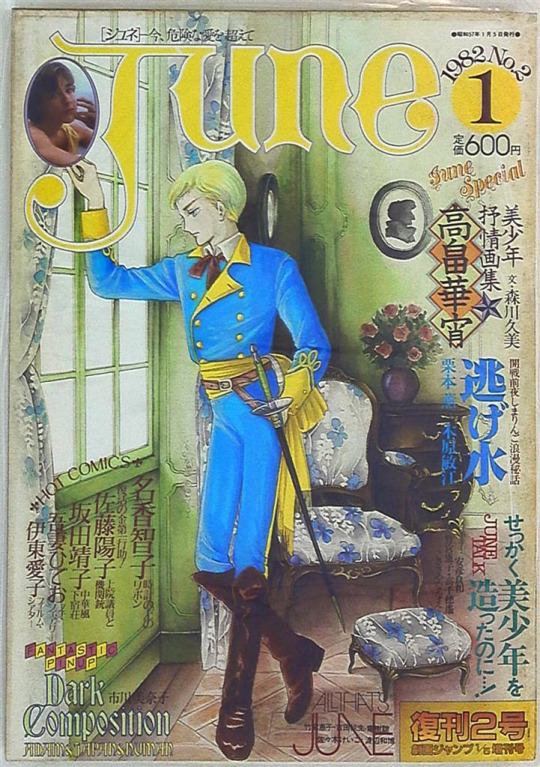
So then I was gonna tell you about how the early shōjo manga focusing on gay relationships, taking the old term shōnen-ai [which originally referred to pederasty], were quite nerdy and literary, but the subgenre rapidly grew in the 70s and 80s, cultivating an otaku audience of its own - primarily women termed, somewhat disparagingly, 婦女子 fujoshi but this demographic breakdown is certainly not absolute and there is a term for male fans, which is 普段し fudanshi. We coulda gone into the whole world of doujinshi, of the massive convention comiket; I coulda cracked open Kimi Rito's History of Hentai Manga for some interesting tidbits about how certain images become encoded as symbols and then reused routinely in manga.
And you know, I might have talked about how this is distinct from manga aimed at gay readers in gay magazines (like the above mentioned 薔薇族 Barazoku) which might be termed ゲイ漫画 gei manga. Perhaps we might mention here the upcoming adaptation of gay manga meme sensation kuso miso technique:
youtube
I was maybe gonna talk a little about some of the older genre conventions of BL; the masc top or 攻め seme and the effeminate bottom or 浮け uke; maybe a little about how yaoi fandom got exported into anime fan culture in the West and the strange phenomenon of the 'yaoi paddle'.

...well, it looks like I managed to skim over all that anyway. Spite works wonders for typing speed, it turns out. But believe me, that's really just surface level stuff. We're working on a followup to the legend of Animation Night 69, so we'll be able to get in a lot deeper in a few weeks~
Anyway, even today, BL and yuri works rarely get adapted into anime in a particularly high profile way. But 'rarely' is not never! In Animation Nights past, well: on Animation Night 69 we watched the delightful 風と木の詩 Kaze to Ki no Uta (The Song of Wind and Trees), an OVA adapting the seminal (ha ha) shōjo manga about a French twink at boarding school. That was the direction of Yoshikazu Yasuhiko, known also for Venus Wars and definitely the subject of a future Animation Night, it was as moving and melodramatic as you could hope from 70s shōjo. Sayo Yamamoto (AN36) brought us the incredibly charming figure gay skating series Yuri on Ice; and then of course Kunihiko Ikuhara (AN155), bless his heart, made his always bold statements on yuri with Yurikuma Arashi ('Lesbian Bear Storm') and BL with Sarazanmai, which I will surely cover if we ever reach the point where we're like 'let's marathon a TV anime' again ;p
Tonight though? We'll be looking at a couple of relatively recent films on both sides of the fence.

For the BL wing, we have the film 海辺のエトランゼ Umibe no Étranger, aka L'étranger de la Plage or Stranger by the Shore. Kanna Kii, the mangaka, had previously worked as an animator at Studio Hibari, a small anime studio that dates back to the late 70s and broadly seems to specialise in shōjo. Kii returned there to design characters and supervise the film, and evidently Hibari were very excited to adapt the work of their alumnus, because they absolutely spared no effort.
The story centres on orphaned highschooler Mio and his neighbour Shun, an aspiring gay novelist on a remote island in Okinawa. The pair grew close three years before the start of the story, but Mio had to leave Okinawa; we join him now as he returns to that same shore, still holding feelings for Shun.
I'll admit, I don't know a ton about this movie - but it comes highly recommended by kvin who described it as one of an 'oasis' of strong BL works released around 2020. And the clips I've seen - well, they're the gifs used in this post, really nicely drawn scenes of affection. So I'm pretty excited!

Our yuri wing... well, there's a few good choices for yuri TV shows I could show you, but tonight it's late and we need something short and sweet, and that really narrows the field! What I have is あさがおと加瀬さん。Asagao to Kase-san [Kase-san and the Morning Glories], a one hour OVA adapting the manga 加瀬さん Kase-san by Hiromi Takashima. The OVA starts partway into the manga, when plant nerd Yui Yamada has already started dating her crush, the athletic Tomoka Kase. It follows the trials of the girls' relationship as they are coming towards the end of their time at school - relatively low-key, slice of life first relationship typea thing.
The animae was adapted by studio Zexcs under the direction of Takuya Satō, who you might remember as director of the first part of Armitage III [AN153]. Zexcs spun out of JC Staff at the end of the 90s, and they've been pretty busy since then - for me their most notable creation is Aku no Hana (The Flowers of Evil), a truly unique rotoscope anime with an incredibly engaging, tense story about teenagers and the imp of the perverse... which sadly never got the love it deserved! yes I'm still beating this drum!
Anyway, while I have not been able to find a ton of production information, I am told at least that Kase-san was a passion project for Satō - evidently a yuri fan given he also took on the adaptation of Otherside Picnic. It began first with five-minute web adaptation Kase-san and the Morning Glories in 2018 that's more of a musical montage of moments from the series, which was then able to be expanded the next year into an hour-long OVA...
youtube
A lot of romance stories focus on the characters getting together, so it's interesting that this one skips right over those chapters of the manga and gets going once the characters are already together, focusing more on the trials of an ongoing relationship between two goofy hormonal kids trying to figure out if this is just a class S thing or something that they want to last. A great deal of effort is put towards character animation, intimacy, the little flinches and reactions. You can read a little discussion about it here on ANN.
So! With apologies for the late start once more (T_T), it's time to begin! Animation Night will shortly be live at twitch.tv/canmom, and I hope you'll join me for a gay old time~
61 notes
·
View notes
Note
Questions because I'm curious! What is your 'holy grail' doll to collect? Have you ever tried making a whole doll from scratch? What's your favourite part of doll restoration? What are your favourite haunts for doll hunting? What doll collectors/restorers do you admire most? And lastly, if you could go back to any period(s?) to get a doll when it was new, what time period(s?) would you go to
Ooooh doll questions! let's go!
Holy grail doll to collect. I already have at least one of them- a late 1860s French fashion doll with an articulated wooden body. She survived the fire and I love her even more for it; her name is Leonore. A few "wouldn't be nice" dolls I don't have yet include:
Antique 18th-century English wooden doll (I have a lovely repro at the moment, Amy)
Simon and Halbig 1159 lady doll
A wax fashion doll. I lost all of mine in the fire, unfortunately
Lenci boudoir doll
Miniature china-headed doll with an articulated wooden body
A Black French fashion doll (SUPER rare, but they did exist)
2. Have I ever made a doll from scratch? Yes, out of polymer clay with jewelry headpins baked in to string her together. She was floppy and had anime eyes drawn on with Sharpie. Not the most successful experiment.
3. Favorite part of doll restoration? Cleaning. They just look so much happier after a bath!
4. Favorite doll-hunting haunts? EBay. Sadly, one doesn't come across the sort of doll I collect in the wild much anymore, though I've had some luck with French fashion doll clothes at the Brimfield Antiques Fair.
5. Admired doll collectors/restoration artists? My friend and Amy's maker, Paul Robinson. Michael Canadas and David Robinson. Kathy Libraty (also a friend- a dealer who does restoration). Illiandra Alvey (another friend). Samy Odin. Kat Davies. Bradley Justice Yarborough (a LOT of these are people I'm friends with). Linda Wall.
6. Time travelling to get a doll when new? 18th-century English wooden. Unless you get VERY lucky, they retail for like $20K right now- the pretty ones in decent condition, that is.
Or an Albert Marque doll, to sell and make like $300K off of.
38 notes
·
View notes
Text
The Restoration of the Royal East India Volunteers Flags

The British Library is celebrating the completion of a four-year project to conserve two unique but badly degraded silk flags dating from the 1790s.
The flags are a set of colours belonging to the Royal East India Volunteers formed by the East India Company in London during the French Wars to protect East India House and the Company warehouses ‘against hazard from insurrections and tumults’ and to assist the City government in times of disorder.
The REIV were embodied at two separate periods, from 1796 to 1814 and then from 1820 to 1834. The field officers were elected from Company directors, and commissioned officers were recruited from clerks and officials at East India House and the warehouses. The supervisory grades in the warehouses became non-commissioned officers who led labourers serving as privates. By 1799 there were three regiments with about 1500 men. A register of labourers in the REIV soldiers 1820-1832 has survived giving age, height, home address, reason for discharge from the corps. Some men were discharged because training clashed with their warehouse duties or secondary afternoon jobs. Others were judged unfit to serve – Charles Twort was discharged for having bad feet and corns.

Each REIV regiment had a set of colours. It appears that Lady Jane Dundas embroidered all three sets. Her husband Henry Dundas wrote to Company director David Scott on 4 November 1796 that Lady Jane had taken a fancy that she ought to work a pair of colours for the East India Corps and that she needed instructions. Lady Jane presented the colours at three public ceremonies in April 1797, July 1797, and June 1799.
One set of colours was presented to the re-embodied REIV on 14 June 1821. When the REIV was finally disbanded in 1834, these colours were deposited in the museum at East India House. Sir George Birdwood found the colours later in the 19th century at the India Store Depôt at Lambeth and placed them in the Military Committee Room at the India Office in Whitehall. They were still on display in Whitehall as late as 1963.
In 1895 the colours were lent to Empire of India Exhibition at Earl’s Court. The catalogue described them as ‘tattered and torn in the most approved fashion but no tale of glory hangs thereby. Only in marches and reviews in London Fields did these colours wave to the breeze, and damp and the ravages of rats and mice are responsible for their present condition’.
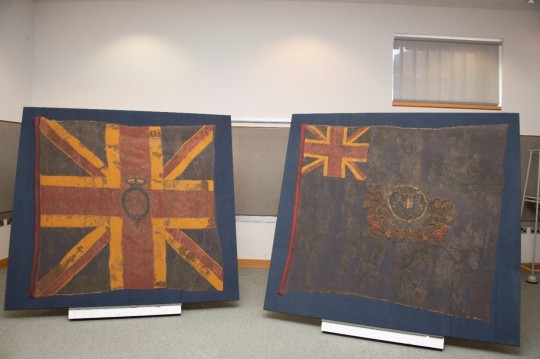
The colours had become fragile, fragmentary and soiled. Large areas of silk loss made the flags very hard to interpret. Surprisingly, the complex embroideries which decorated the centre of the flags were predominately intact although structurally very weak.
The conservation treatment of these two flags included: surface cleaning; removal of the central embroideries; wet cleaning; crease removal; mounting on a padded board covered by a digitally printed image of the flag to enable interpretation and covering with a specially dyed nylon net which prevents the loss of the fragmentary silk.
The conservation will enable access, display and research by ensuring the longevity of these precious and important flags.
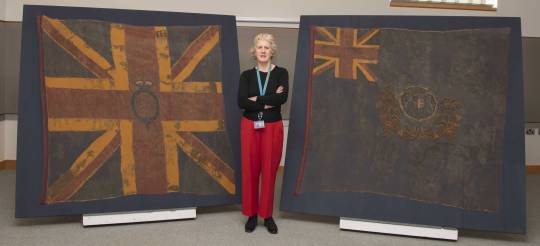
SOURCE
27 notes
·
View notes
Photo


Some 1820s dresses (from top to bottom) -
1824 Young elegant lady by Eduard Friedrich Leybold (Christie's - Live Auction 2975 Lot 360). Fixed tears, edges, spots, and smudges w Pshop 3342X4205 @150 2.5Mj.
1826 Josefina Maximiliana Eugenia Napoleana, Queen of Sweden with her son by Frederic Westin (location ?). From tumblr.com/roehenstart 1280X1898 @72 587kj.
#1820s fashion#French restoration fashion#late Georgian fashion#Eduard Friedrich Leybold#short hair#bateau neckline#upper-puffed long sleeves#folded-ribbon bertha#waist band#close skirt#shawl#Queen Josefina#Frederic Westin#turban#dual sleeves
81 notes
·
View notes
Text
tuesday again 10/24/2023
this post and this series not sponsored by hellofresh
listening
caravan palace's new single MAD. genuinely the song i've had on loop while working but i had a very strong "ugh can't use that one it's cringe" reaction while drafting this entry and am trying to sort of sit with myself for a bit and go okay WHY is it cringe? how can we talk about it being cringe other than the fact that steampunk and electroswing are no longer fashionable? some weeks the policy of No Such Thing As A Guilty Pleasure is easier than others
i would not classify this song as electro or swing, and it's considerably jazzier than their more recent dancey pop stuff. more of a languid stroll with enough brass to keep my brain interested while i peer at spreadsheets? spotify
youtube
-
reading
Alexis Hall's A Lady for a Duke. i liked this quite a bit but i have some longer form thoughts percolating that require a reread. it was a tense but fun read, i do not know that mr hall achieved the goal he set forth below. in a broad initial stroke, there is certainly a great deal of internal conflict not helped by our trans lead’s difficulty seeing her trans self in a loving relationship.
how this conflict resolves did genuinely keep me on the edge of my seat bc i could not fucking figure out how she was going to do it
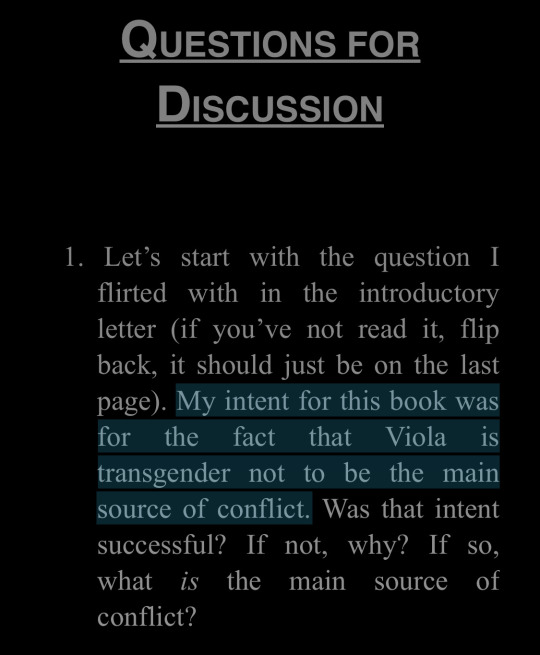
-
watching
Pandora and the Flying Dutchman (1951, dir Lewin). this is a movie where (in the immortal words of the switchblade sisters podcast) it’s not what happens, but how it happens. the movie opens with fishermen dredging up two star-crossed lovers. i will not be particularly concerned with spoilers here or in my letterboxd review.
age and a deft scorsese-backed restoration have been very kind to this sea-mist movie. cinnamon fucking topography, technicolor at some of its prettiest and best used. jack cardiff (also did Black Narcissius, The Red Shoes, The African Queen) you've fucking done it again. the restored version is on american tubi and it's so so lush and dreamy. the very first handful of scenes contains a church bell ringing wildly, giving you glimpses of commotion on the beach, and it just keeps getting better from there. the beach party, full of dutch angles and toppled statuary and debauchery and no one dancing the same, is exactly the same as every beach party i have ever been to.
james mason is at his hottest, wettest, and most brooding. not all of our main characters are as openly debauched as pandora, but all of them are just as selfish. i have a lot of fucking beef with some of the letterboxd reviewers, who are simply wrong. pandora is not supposed to be a likeable or redeemable character. i think one of the questions for YOU to answer is whether or not a flighty, homewrecking, irresponsible woman like pandora is redeemed through her willingness to die for true love-- this is generally an admirable quality in myths and fairy tales, but is it cancelled out as just another flight of her fancies that ultimately kills her?
also the people who don't "get" what the film's about and complain it's too slow. it's about insanity and the sea what's not to get!!!
youtube
thank u @dying-suffering-french-stalkers
-
playing
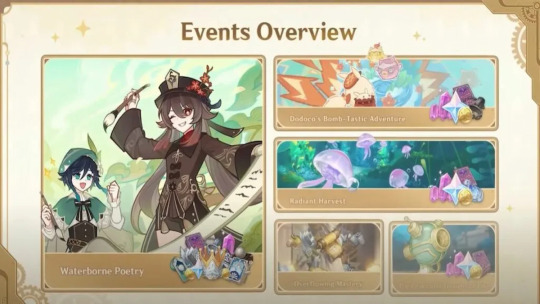
so we are mostly through the genshin 4.1 part 2 events. i am so tired of the past few battle events cycling through the same arenas; however, this is the first event where i read the directions and was like "augh that's too complicated we'll do that later" and did all my weekly bounties instead. speaking of bounties, i finally did enough to unlock the treasure chest locator and confirmed my suspicions that i have in fact picked over the region pretty well in the last ~two months. the liffey and research institute were at 85% and 95% respectively before i unlocked this thing, but i did almost immediately find two remarkable chests in the far south by the port. augh. would have bit me if they had teeth etc. i would prefer if the regions showed 100% when i have actually 100%ed them instead of whatever margin they have going now, but i recognize that i have brain problems.
-
making
im MAD bc i was given a singular hellofresh dinner by a friend going on vacation and it was fairly easy to make and tasted good and everything WORKED. and it was like a fun little after work project!!! and the directions said “here’s what to do to the peppers if you don’t want it super spicy” and it most importantly it all WORKED. this is a very expensive thing to have a sudden interest in. i feel like i fuck up most of the food i make and i know that's part of the learning curve but it's SO fucking expensive to fuck up food and i have such a limited amount of energy :<
29 notes
·
View notes
Text

Referred to as the ‘Côtes de Melon’, after the distinctive pommel shaped like the ‘ribs of the melon’. This sabre style gained popularity among French officers from about 1800 and remained in use until the introduction of the model 1821 infantry and 1822 cavalry sabres during the Restoration era.

Aside from the pommel, the type is distinguished by the simple stirrup hilt with langets and a single quillion. The grips are made from hardwood and can be checkered or have longitudinal groves. Often the knuckle guard has a stylised olive decorative feature. Swords belonging to superior officers would have been silver-plated.
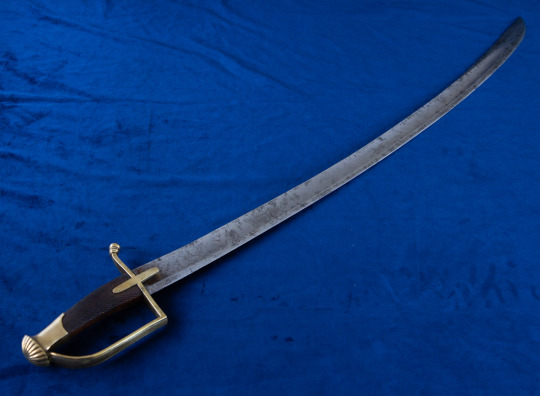

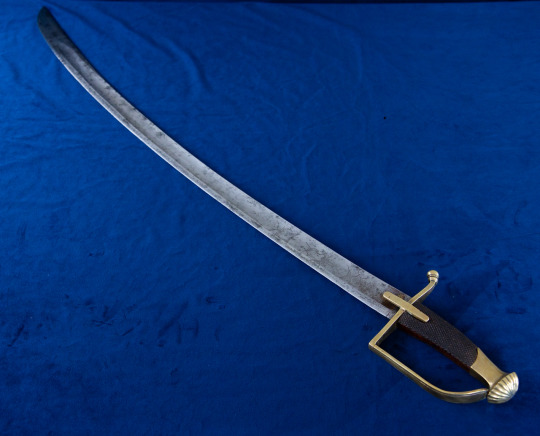
The swords of mounted or cavalry officers can be identified by their length and dual suspension rings on the scabbard. Superior officers typically had ornate metal scabbards, while infantry officers preferred shorter sabres with a frog stud for use with the cross-belt.
An officer of one of the light cavalry regiments most likely owned this sabre. The blade is particularly large and sturdy, plus the scabbard has dual suspension rings. The blade is decorated in the typical oriental fashion of the late 18th Century with faux Islamic / cabalistic script and an ‘Ottoman’s head’. There is a lovely Solingen rose on the blade's spine but no other identifying manufacturer's marks.



The simple ‘baguette’ shaped langets, blade decorations and plain knuckle guard may indicate that this is an early example of the type, or that it was used by an officer of another nation, imitating French fashion.

Overall Length: 965 mm
Blade Length: 825 mm
Grip Length: 130 mm
Inside Grip Length: 110 mm
Sword Weight: 800 grams
Total Weight: 1050 grams
Point of Balance: 180 mm
Curve: 37 mm
#Sword#Sabre#côtes de melon#French#French Army#French Cavalry#Napoleonic Wars#Consulate era#First Empire#Antiques#Military Antiques#Cavalry Swords#Light Cavalry
83 notes
·
View notes
Text
Actually, @lightandfellowship asking about other Dark Road historical fashion thoughts on this post did kind of get me thinking about it and you know what I think is really interesting? Is that there are only two students that are at any point wearing entirely Western-looking (non-Japanese) clothing without an obi and obijime, and that’s Xehanort (pre-arrival at Scala)...
And Baldr.
Even Master Odin is wearing an obi and obijime despite otherwise dressing like Gandalf, but we’ll leave him aside for the sake of this discussion.
For the most part the students are wearing fusion clothing, but that’s typical of the Taisho era. The Taisho period, which immediately followed the end of the Meiji Restoration, was a period of great change in Japan, and of Westernization. It was very common for people to wear a mix of Western clothing with traditional Japanese clothing. You can see a lot of this in the Dark Road students;
(This got really long lol. Discussion of the secondary and tertiary Dark Road students’ design choices, culminating in discussion of Eraqus, Xehanort, and Baldr’s designs and what they might mean in the context of a Taisho-period-adjacent setting, under the cut).
- Most of the male students, plus Urd, are wearing very loose, bloused pants, probably tobi trousers or karusan-bakama.
- Vidar, Vali, and Vala have some of the most traditionally Japanese silhouettes among the upperclassmen. Vidar is wearing a sleeveless lapped garment that isn’t strictly traditional, but has a very Japanese look to the way it’s assembled and to the color styling, while Vali is wearing pretty authentic-looking Japanese faulds, and is obviously supposed to make you think of the kabuki ideal of a ninja. Vala also looks EXTREMELY Taisho-period; the wearing of silk-painted or embroidered, brightly-colored hakama with an obi and furisode or kosode was extremely common for girls in the Taisho period. Vala has some sort of fantasy puff cuff-sleeve-thing instead of furisode, but her hakama and obi are lifted straight out of the 1910s. Interestingly, these upperclassmen, like Eraqus in the lower class, survive the longest.
- Heimdall, Sigrun, and Bragi are all wearing a mix of actual traditional Japanese clothing and Western elements. They are all wearing short kimono, with Sigrun having a very classic obi styling, Bragi is wearing traditional workman’s clothing (a hanten and sarubakama, with an obi without obijime, interestingly), and Heimdall appears to be wearing a kosode, with obi and obijime. However, Sigrun is wearing leggings and gaiters, Heimdall has some WILD thigh-high Three Musketeers boots and that very intensely high-collared, French-looking bolero jacket, and Bragi is, as previously discussed, wearing a bomber jacket (and also Chuck Taylor sneakers, Bragi you sneaky, deeply anachronistic guy).
- Helgi and Hoder, interestingly, appear to be blending Japanese and Chinese clothing styles; they’re both wearing obi and obiage, but Hoder appears to be wearing a cheongsam, and while Helgi is wearing a sleeveless kimono as a shirt, his fur ruffs very much evoke some traditional theatrical depictions of Son Goku (the Monkey King not the DBZ character); but I’m not that knowledgeable about Chinese clothing so I won’t make too many conjectures here.
- Urd and Hermod and Vor all have very fantasy-like designs, with the girls having fewer garments from either real Western or Japanese styles. Hermod and Urd as discussed have the bloused pants, Vor’s coat looks VERY much like a traditionally silk painted kimono that’s been altered to have a Western tab-collar, but has a traditional Japanese rope bow on the back, and all three are wearing obi and obiage. However, Urd’s robe/cape thing is VERY Western Fantasy Wizard, meanwhile Vor is wearing actual pumpkin pants. Hermod’s looks the most period, with his haori retaining the traditional lapels but altered to have Western bishop sleeves, and he’s wearing VERY WWI-style gaiters.
Now lets talk about the other three, who are actually our main characters; Xehanort, Baldr, and Eraqus.
Eraqus is absolutely wearing nothing but traditional Japanese clothing (aside from the obvious Kingdom Hearts elements of the turtleneck and crossed suspenders). He is wearing extremely traditional hakama, with the most traditional haori of any of the cast. His hair is partially loose but what is pulled back is pulled into something like a topknot; Eraqus is designed in every way to evoke the look of the samurai class. What I think is significant with that is that, as mentioned, the Taisho period followed the Meiji Restoration, when the samurai class in Japan were more or less disbanded in the face of modernization of Japan. I don’t think it’s unrelated that at this point, the Scalan society that considers Eraqus a ‘blueblood’ is also in decline, and is ultimately ended within Eraqus’s lifetime. He is the last of his kind, and he is dressed like it.
Then, there’s Xehanort. When he leaves Destiny Islands to go to Scala he’s dressed in an outfit that calls to mind Ephemer’s, and is extremely Western and modern-looking; which makes sense, since he was raised by Player, and the KHUX time period has very modern and Western fashion (remember Bragi’s Chucks?). But once he’s a student, he’s replaced his button-down shirt and collared sleeveless duster with a turtleneck (Kingdom Hearts, lol) and haori of his own, an exact photo negative of Eraqus’s haori except that Xehanort’s is sleeveless. But Eraqus is a blueblood, and as far as anyone in Scala knows, Xehanort is a nobody and a foreigner; he is still wearing Western pants in a Western style, held up by a Western belt and without any obi in sight. Xehanort was born in Scala, and he resents being seen as Just Some Guy, but he doesn’t belong there like Eraqus does; his haori on top is trying to make him part of that world, an equal to Eraqus, but what’s underneath reflects that Scala doesn’t consider him either of those things.
And then, there is Baldr.
I’ve seen other posters point out that his clothing is all black, under a white jacket (I’m sorry I don’t remember who pointed this out!), but also, Baldr has the most Western and contemporary clothing of all of the characters in Dark Road. In contrast to Xehanort, with his loose, pre-WWI-era jeans, Baldr is wearing contemporary skinny jeans with a wallet chain and fashionable low-buckled boots. He’s also wearing a waistcoat, and a bolero jacket with what looks like knit cuffs. He doesn’t fit in with the others at all, even less than Xehanort does.
And pointedly, like Xehanort, he is not wearing an obi.
I feel like it’s not a coincidence that this game visually sets its characters in the Taisho era, the time period that transitioned Japan from the traditional Japan to the modern, Westernized Japan of the 20th century, and the character who puts a permanent end to Scalan society is the only character dressed entirely in Western and modern clothing. Obviously I can’t say for sure what the intent was, but at the end of the game, the three characters left standing are Eraqus, dressed in the most traditionally Japanese fashion, Baldr, dressed in the least, and Xehanort, the fusion, who is dressed like Eraqus on the surface, but underneath, is dressed like Baldr.
#KHDR#Kingdom Hearts#Kingdom Hearts Dark Road#long post#related to; fashion history#In case this seems like talking out of my ass lmao my qualifications are I have a degree in fashion#with a focus on fashion and costume history#did my final graduating paper on how modern Japanese street fashion#was influenced by Meiji and Heian and Taisho fashion#and also worked as a professional costumer for the theater industry for several years#Butttt it's been a little bit so there may be inaccuracies#but these are my thoughts from like. A costume design perspective and how costumes inform character for narrative purposes
35 notes
·
View notes
Text
Coming in March!
Crimes of Fashion: Killer Clutch - March 15th (HM&M)
An American psychologist, hired to coach a fashion designer, helps a guarded French detective unravel a list of fashionable suspects after a murder happens backstage of a Paris fashion show. Stars Brooke D'Orsay and Gilles Marini.
Shifting Gears - March 23rd (HC)
After female mechanic Jess reluctantly agrees to participate in a car restoration show, she is shocked to learn that her ex-boyfriend, Luke, is her main competitor. Will sparks reignite? Stars Tyler Hynes, Katherine Barrell.
An Easter in Bloom - March 30th (HC)
A young gardener sets out to save her family farm by entering a floral competition for Easter. She meets a local pastor along the way who helps her restore the hope she lost. Starring Aimeé Teegarden and Benjamin Hollingsworth.
11 notes
·
View notes
Text
Just saw Prey on Hulu.
Holy shit. Holy SHIT!
This is the best Predator movie since the original with Arnie! I love it to death and it has instantly become one of my favorite action/horror movies.
And now, some more ideas for historical Predator movies.
-
Predator: For Honor
Taking place in Sengoku era Japan, the year 1500 to be precise, our hero is a young Samurai warrior named Akira. When a battle ends with their enemy commanders being slaughtered and butchered by an unknown enemy, Akira learns of a terrible and dark legend of his homeland.
Every one-hundred years, when heat and conflict are at their highest, a demon descends from the heavens and seeks the mightiest warriors to hunt and slay. The last time it came, it was slain by Akira’s ancestor who fashioned it's mask into the helmet for his family armor. Now, one hundred years later, that demon’s son is here to wipe out Akira’s clan and restore it’s honor.
As people close to Akira begin dying, he must cast aside his fear and self-doubt and force a final confrontation between him and the creature. A duel, from which only one warrior will emerge victorious.
-
Alien vs Predator: Gevaudan
It is the late 1760′s, and a monster hunts the woods around the French village of Gevaudan. It hunts at night, and kills at will, and none have been able to even so much as see the beast and live to tell the tale. The people live in fear of the woods, cut off from the rest of the world.
However, innkeeper and farmer Jean Chastel soon discovers the truth. It is no wolf who hunts the woods of Gevaudan, it is a demon of the night, a scaly thing of pure black that emerged from a fallen star.
Jean tries and fails to slay the beast and narrowly escapes with his life, thanks to the intervention of a mysterious monster. A two-legged lizard creature, just as alien as the Beast, but perhaps a bit more human.
Jean and the hunter from the stars must join forces in order to slay the Black Demon: the Beast of Gevaudan.
-
Predator: Black Flag
Taking place during the Golden Age of Piracy, our main character is Louise Poulneax, an escaped slave who has joined the pirate crew of Captain Avery “Blacksmith” Gordon, a former British Captain who led a mutiny and took up piracy when he was ordered to move slaves by his commander. Now he terrorizes the Atlantic and Carribean in his ship: The Artemis.
After raiding a Spanish Galleon, Louise finds a mysterious weapon, a spear-like thing that can collapse in on itself. Louise takes it, thinking it just another prize, but soon the pirate crew are being hunted in every port, butchered and hung up to dry like deer and rabbits.
Soon Louise and Captain Gordon must prepare to face the demon hunting their crew for daring to hold onto it’s technology. The pirates will need all their will to survive against a demon such as this.
#incorrect super smash bros#super smash bros#Predator#Prey 2022#Prey#Alien#Alien vs Predator#Gevaudan#Sengoku Japan#Samurai#Pirate#Pirates#idea#ideas#thoughts#film idea
325 notes
·
View notes